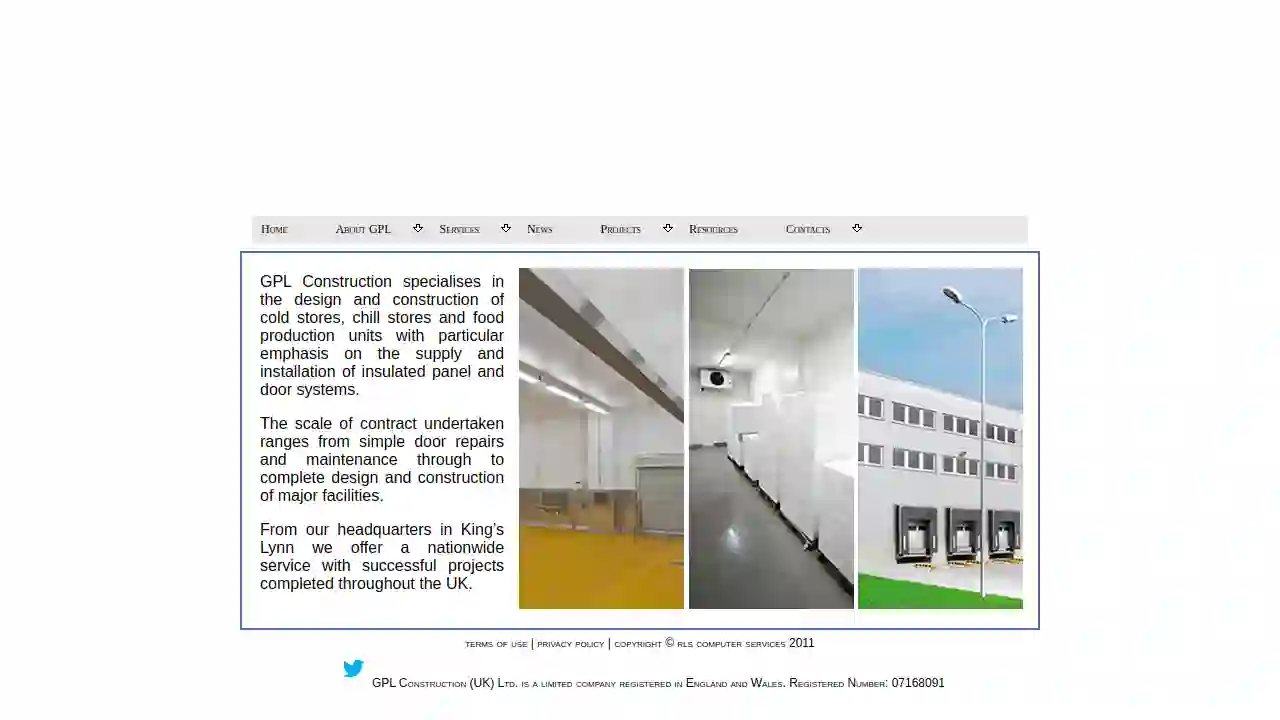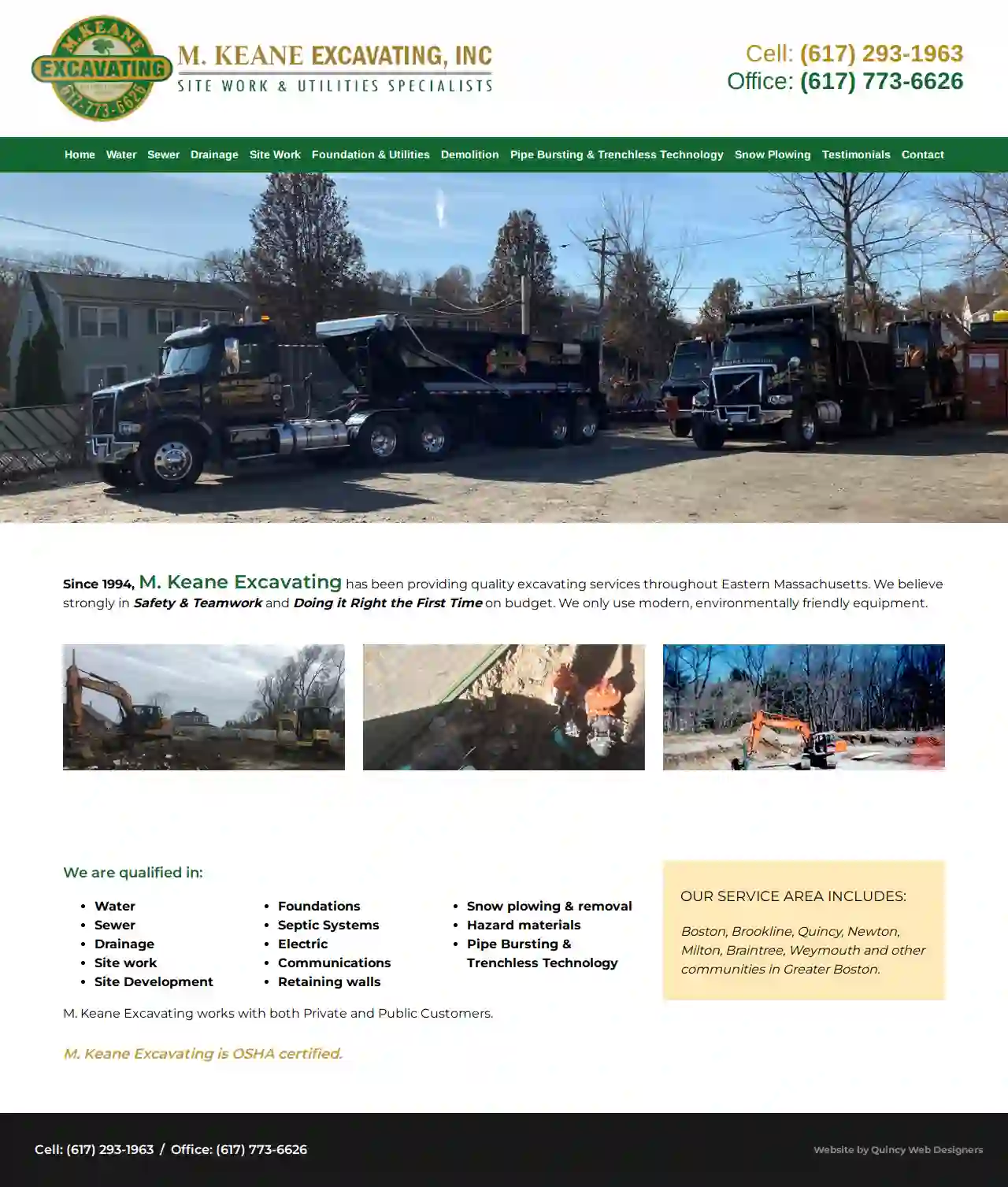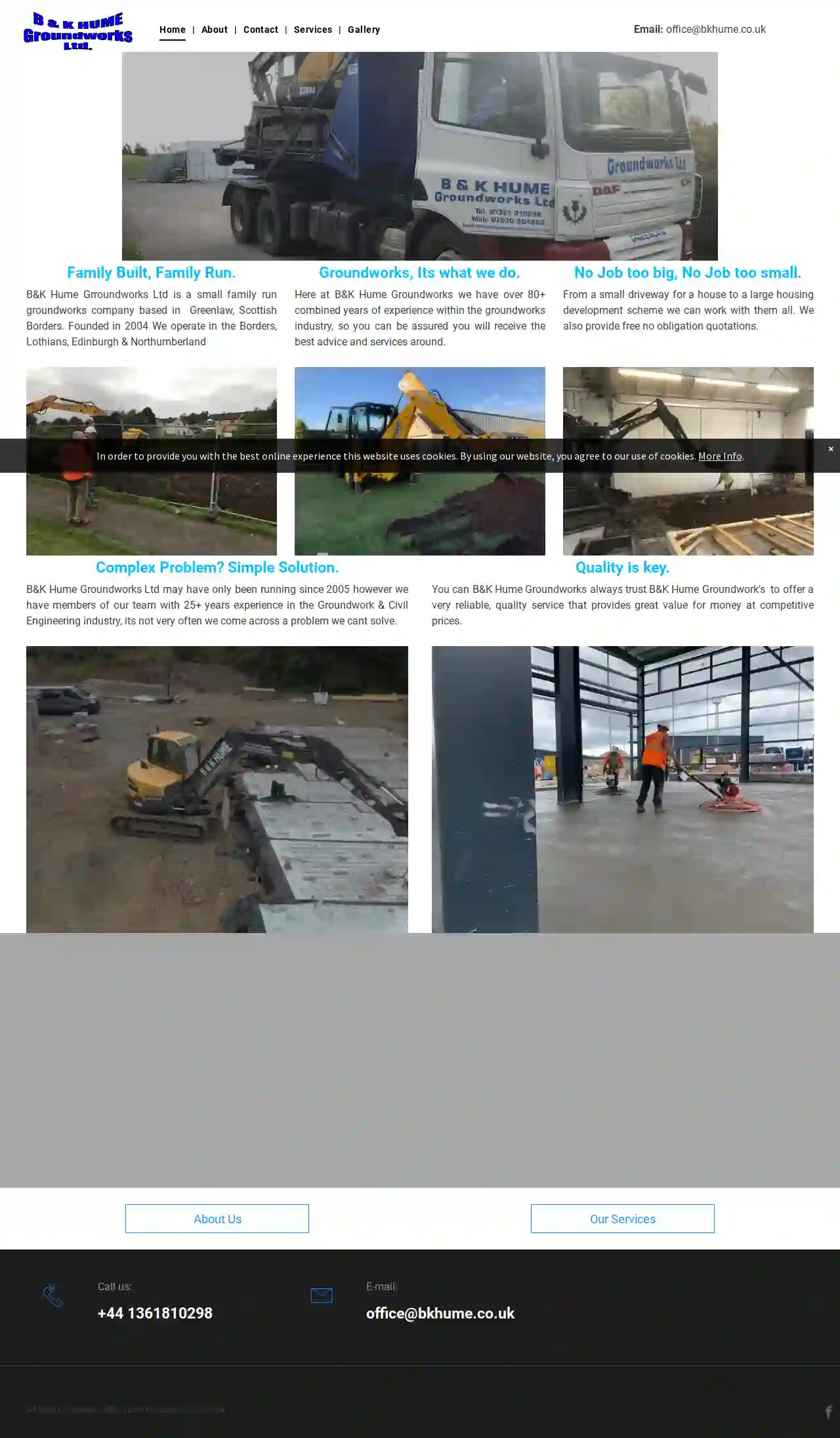Excavation Contractors Shelford
Top 10 Excavation Companies in Shelford
Get 3 FREE Excavation Companies quotes for your project today! Compare profiles, reviews, accreditations, portfolio, etc... and choose the best offer.

N.B.O’Shea Construction
54 reviewsEly, GBWelcome To N B O'Shea Construction Looking for a local construction company? N B O'Shea Construction is a family-run business with over 20 years of experience in the construction industry. We are proud to be recognised as Master Craftsmen and are committed to providing our clients with the highest quality workmanship and customer service. We offer a wide range of services, including: Paths and driveway construction Patios Minor demolition Fencing repairs New soakaways Small brickwork jobs, brickwork repairs and brickwork repointing Construction and groundwork Electrical kiosk bases and associated ducting Drainage Work Concreting Works Excavation work for ducts and cables Registered Waste Carrier Septic tank installation We are based in King's Lynn, Norfolk and cover North Norfolk and North West Norfolk. We are fully insured and accredited by The Guild of Master Craftsmen. We are committed to providing our clients with a professional and reliable service. We are also committed to using sustainable and environmentally friendly practices. We are proud of our reputation for quality workmanship and customer satisfaction. We are confident that we can provide you with the construction services you need.
- Services
- Why Us?
- Accreditations
- Testimonials
- Gallery
Get Quote
G P L Construction (UK) Ltd
51 reviews18 Hodgson Way, Hardwick Narrows, Kings Lynn, Norfolk, King's Lynn, PE30 4WR, GBGPL Construction: Your Trusted Partner for Cold Storage Solutions GPL Construction (UK) Ltd is a family-run business with over 22 years of experience in the design and construction of cold stores, chill stores, and food production units. We are firmly established as one of the UK's leading performers in our market, offering a nationwide service with a commitment to delivering quality projects on time, within budget, and with minimal disruption to our clients' existing operations. Our team of experienced, multi-skilled operatives share a common vision and commitment to delivering the highest standards. We pride ourselves on our exceptional customer service, reliability, and quality of work, ensuring that each project receives the same high level of attention, whether it's a simple repair or a large-scale design and build project. From our headquarters in King's Lynn, Norfolk, we have successfully completed projects throughout the UK, ranging from simple door repairs and maintenance to the complete design and construction of major facilities. We specialize in the supply and installation of insulated panel and door systems, and we are well-placed to select the best materials for individual contracts without being tied to a specific product range. Our commitment to continuous improvement is reflected in our regular review of health and safety policies and our ongoing training programs. We are an approved contractor under the SafeContractor Scheme, which assesses the health and safety competency of suppliers and their service providers. This accreditation is recognized by many large organizations as their primary means of selecting contractors. We are a progressive company and welcome the opportunity to talk to people who can offer GPL their wealth of experience, are well qualified, and pride themselves on having good standards of work.
- Services
- Why Us?
- Accreditations
- Our Team
- Gallery
Get Quote
Alfred Fach Excavating LTD.
56 reviewsRR 21 Kossuth Road, Cambridge, N3C 2V3, GBBuilding Relationships That Last With each project, the goal of Alfred Fach Excavating is to build and maintain relationships with our customers. This is accomplished through effective communication and focus on quality. Alfred Fach Excavating for your commercial and municipal needs Since the beginning some 40 years ago, Alfred Fach Excavating has been committed to quality, innovation and forward thinking. The company continues to stay ahead of the changing technological challenges that are presented in an ever changing construction industry. Through over 4 decade & different aspects of the industry, this company has developed a highly professional and trusted brand name in excavation in Ontario. Company Goals Alfred Fach Excavating is a quality focus organization with a staff of nearly 30 employees, with projects spanning across most of the province of Ontario.
- Services
- Why Us?
- Gallery
Get Quote
G&J Groundworks (Jedburgh) Ltd
59 reviews1a Grahamslaw Close High Street Jedburgh, Jedburgh, TD8 6AA, GBLaying the Groundworks Established in 2000, G+J Groundworks has built a strong reputation for delivering a full range of specialist groundwork services. We've achieved this by providing every client with the same attention to detail and exceptional levels of customer service on every single project, ensuring that we deliver a first-class job every time. This combination of quality and commitment means that we enjoy extremely high levels of repeat business and recommendations from our clients, many of whom we have worked with for almost 20 years. Our core business is providing groundwork services for commercial clients and local authorities and we are proud to be a Scottish Borders Council Approved Contractor and are a fully verified company with Acclaim and Construction Line. As experts in all aspects of excavation, drainage and concrete, clients also know that we have the versatility to deliver all of their groundwork requirements. From the preparation of new factory sites and agricultural developments to making sure that new housing development sites are build ready. We have a wealth of experience and would be delighted to introduce you to G+J Groundworks and have the opportunity to discuss your individual requirements with you. For more information or to arrange a meeting, please contact one of the team.
- Services
- Why Us?
- Our Team
- Gallery
Get Quote
M. Keane Excavating
13 reviews87 Madison Ave, Quincy, 02169, GBAbout M. Keane Excavating Since 1994, M. Keane Excavating has been providing quality excavating services throughout Eastern Massachusetts. We are committed to safety, teamwork, and doing the job right the first time, on budget. We utilize modern, environmentally friendly equipment to ensure the highest quality work. Our Services We are qualified in a wide range of excavating services, including: Water Sewer Drainage Site work Site Development Foundations Septic Systems Electric Communications Retaining walls Snow plowing & removal Hazard materials Pipe Bursting & Trenchless Technology M. Keane Excavating works with both private and public customers. We are OSHA certified and committed to providing exceptional service to every client. Our Service Area Our service area includes: Boston Brookline Quincy Newton Milton Braintree Weymouth And other communities in Greater Boston
- Services
- Why Us?
- Testimonials
- Gallery
Get Quote
Sussex Land Works
52 reviews24, The Croft, Cocking, West Sussex, GU29 0HQ, GBWest Sussex Groundwork Contractor - Excavation, Site Clearance, Concreting & More Sussex Land Works is a West Sussex groundwork contractor. Based close to Chichester and Midhurst we have more than 25 years of experience in providing groundwork services and take pride in our reputation for quality and reliability at a competitive price. Much of our business comes from word of mouth recommendation. We operate throughout West Sussex, Surrey and East Hampshire and specialise in all aspects of Groundwork, Excavations and Concreting, including Landscaping. We also carry out Septic Tank and Waste Water Treatment Plant Installations in association with our sister company Sussex Water Treatments. Sussex LandWorks offers groundwork and excavation services to both commercial and domestic clients and carry out work to suit all specifications, across a wide range of projects, including drainage, landscaping and concreting projects to roads, sewers and service installations. We have a strong background in developing and supporting rural businesses, including agriculture, riding stables, country parks, fishing lakes etc as well as offer a wide range of domestic garden groundwork and hard landscaping services including laying of driveways, pathways and patios. Whatever your project we will ensure that all work undertaken is carried out with the same level of care and attention to detail and finished to the very highest specification. We operate our own fleet of plant and machinery and offer machine and operator hire to customers if required. Equipment includes excavators, trenching machinary, dumpers, small plant, etc. and all plant and equipment is maintained to high standards and our operators are trained to meet Health and Safety requirements.
- Services
- Why Us?
- Gallery
Get Quote
B & K Hume Groundworks LTD
51 reviewsWillowbank, TodholesGreenlaw, Duns, TD10 6XD, GBFamily Built, Family Run. B&K Hume Groundworks Ltd is a small family run groundworks company based in Greenlaw, Scottish Borders. Founded in 2004, we operate in the Borders, Lothians, Edinburgh & Northumberland. Groundworks, It's what we do. Here at B&K Hume Groundworks, we have over 80+ combined years of experience within the groundworks industry, so you can be assured you will receive the best advice and services around. No Job too big, No Job too small. From a small driveway for a house to a large housing development scheme, we can work with them all. We also provide free no obligation quotations. Complex Problem? Simple Solution. B&K Hume Groundworks Ltd may have only been running since 2005, however, we have members of our team with 25+ years experience in the Groundwork & Civil Engineering industry, it's not very often we come across a problem we can't solve. Quality is key. You can always trust B&K Hume Groundworks to offer a very reliable, quality service that provides great value for money at competitive prices.
- Services
- Why Us?
- Accreditations
- Our Team
- Gallery
Get Quote
Sussex Groundworks
Lancing, West Sussex, United Kingdom, GBExperienced Groundwork Contractor in Sussex. Call Now For Our FREE Quotation. Located in Lancing, Sussex Groundworks cover all aspects of groundworks in Sussex from demolition, land clearance, footings and substructure, while also working for homeowners, property developers and commercial clients. Sussex Groundworls offers a wide range of groundwork solutions for clients in Sussex and the south east of england. Contact us today for further information.
- Services
- Why Us?
- Testimonials
- Gallery
Get Quote
Brady garden & landscape services ltd
Ely, GBAbout Us We are a fast, friendly & reliable team of Landscape Gardeners working through out Barrow in Furness, Dalton in Furness, Ulverston, Grange over Sands, Coniston and the South Lakes / Cumbria area. We are dedicated to also providing Lawn Care, Garden & Grounds Maintenance, general site clearance, grass cutting domestic and commercial, weed control, hedge cutting and much more. We are experienced and we love what we do. We specialise in everything we do, hard and soft landscaping including patios, driveways, block paving, artificial grass, turfing, stone walls, brick walls, planting trees, sitting and barbecue areas, secluded retreats, fencing, steps, digger work, groundworks, drainage / suds, ponds and concrete bases. We are Marshalls Registered Accredited Installers for driveways and patios, City and Guilds qualified and members of the Guild of Master Craftsmen. With over 20 years experience and many established customers, from private domestic gardens to large country estates we focus on delivering a friendly, reliable, professional service. It is because we count listening amongst the most important aspects of our job, that we have so many satisfied clients. Delighted that we have created a garden which is their own and shows their personalities No job is too big or too small, if you have a job that needs taking care of by a group of highly skilled, friendly professionals, please ring today for an informal conversation.
- Services
- Why Us?
- Accreditations
- Testimonials
- Gallery
Get Quote
Wiles Construction Ltd.
Ely, GBTransforming spaces, building dreams At Wiles Construction Ltd., we're dedicated to bringing your vision to life with our expert landscape design, construction, total groundworks solutions and bespoke fabrications. Whether you are a homeowner or commercial landowner, we have every solution covered. For our commercial customers, our groundworks services can cover anything from repair and installation of drainage, to preparing construction site grounds and laying of tarmac or concrete for car parks and yards. See below for just some of our most recent projects. For more examples of our work see our 'Gallery' and click here We will consult with you to design your perfect project and will see it through to completion using the highest quality of materials and with a professional finish.
- Services
- Why Us?
- Testimonials
- Gallery
Get Quote
Over 13,059+ Excavation Pros on our platform
Our excavation contractors operate in Shelford and beyond!
ExcavationHQ has curated and vetted the Best Excavation Businesses in and around Shelford. Find a top & reliable business today.
Frequently Asked Questions About Excavation Contractors
- Determining Soil Suitability: Assessing whether the soil can support the intended structure or load.
- Recommending Foundation Types: Advising on the appropriate foundation design based on soil characteristics.
- Addressing Drainage and Erosion Issues: Providing solutions to manage water runoff and prevent erosion.
- Evaluating Slope Stability: Assessing the risk of landslides or soil movement on slopes.
- Building on challenging soil types (expansive clay, loose sand, etc.)
- Constructing large or complex structures
- Excavating near slopes or retaining walls
- Addressing drainage or erosion concerns
- Hauling to Designated Disposal Sites: Transporting excavated material to approved landfills or recycling centers.
- Recycling or Reuse: If suitable, some excavated soil might be recycled for other projects or reused on-site for landscaping or backfilling.
- Complying with Regulations: Adhering to local and environmental regulations for soil disposal to prevent contamination or illegal dumping.
- Clearly Define the Scope: Outline the project's goals, including the excavation area, depth, grade, and intended use.
- Obtain Necessary Permits: Research and acquire any required permits from your local authorities.
- Mark Utility Lines: Contact your utility companies to locate and mark underground utilities to prevent damage.
- Communicate with Neighbors: Inform your neighbors about the project's timeline and potential noise or disruptions.
- Prepare the Site: Clear any obstacles, such as vegetation, furniture, or structures, from the excavation area.
- Discuss Safety Protocols: Review safety procedures with the contractor to ensure a safe work environment.
- Soil Type and Stability: Stable, cohesive soils allow for deeper excavations than loose or unstable soils.
- Groundwater Level: Excavations below the water table require dewatering techniques to manage water intrusion.
- Equipment and Resources: The size and capabilities of excavation equipment influence the achievable depth.
- Safety Regulations: OSHA and other safety regulations impose limitations on trench depths without proper shoring or sloping.
- Project Requirements: The purpose of the excavation (basement, pool, foundation) determines the necessary depth.
What is a soil engineer, and do I need one?
How do you handle soil disposal after excavation?
What should I do before excavation starts?
How deep can you excavate?
What is a soil engineer, and do I need one?
- Determining Soil Suitability: Assessing whether the soil can support the intended structure or load.
- Recommending Foundation Types: Advising on the appropriate foundation design based on soil characteristics.
- Addressing Drainage and Erosion Issues: Providing solutions to manage water runoff and prevent erosion.
- Evaluating Slope Stability: Assessing the risk of landslides or soil movement on slopes.
- Building on challenging soil types (expansive clay, loose sand, etc.)
- Constructing large or complex structures
- Excavating near slopes or retaining walls
- Addressing drainage or erosion concerns
How do you handle soil disposal after excavation?
- Hauling to Designated Disposal Sites: Transporting excavated material to approved landfills or recycling centers.
- Recycling or Reuse: If suitable, some excavated soil might be recycled for other projects or reused on-site for landscaping or backfilling.
- Complying with Regulations: Adhering to local and environmental regulations for soil disposal to prevent contamination or illegal dumping.
What should I do before excavation starts?
- Clearly Define the Scope: Outline the project's goals, including the excavation area, depth, grade, and intended use.
- Obtain Necessary Permits: Research and acquire any required permits from your local authorities.
- Mark Utility Lines: Contact your utility companies to locate and mark underground utilities to prevent damage.
- Communicate with Neighbors: Inform your neighbors about the project's timeline and potential noise or disruptions.
- Prepare the Site: Clear any obstacles, such as vegetation, furniture, or structures, from the excavation area.
- Discuss Safety Protocols: Review safety procedures with the contractor to ensure a safe work environment.
How deep can you excavate?
- Soil Type and Stability: Stable, cohesive soils allow for deeper excavations than loose or unstable soils.
- Groundwater Level: Excavations below the water table require dewatering techniques to manage water intrusion.
- Equipment and Resources: The size and capabilities of excavation equipment influence the achievable depth.
- Safety Regulations: OSHA and other safety regulations impose limitations on trench depths without proper shoring or sloping.
- Project Requirements: The purpose of the excavation (basement, pool, foundation) determines the necessary depth.